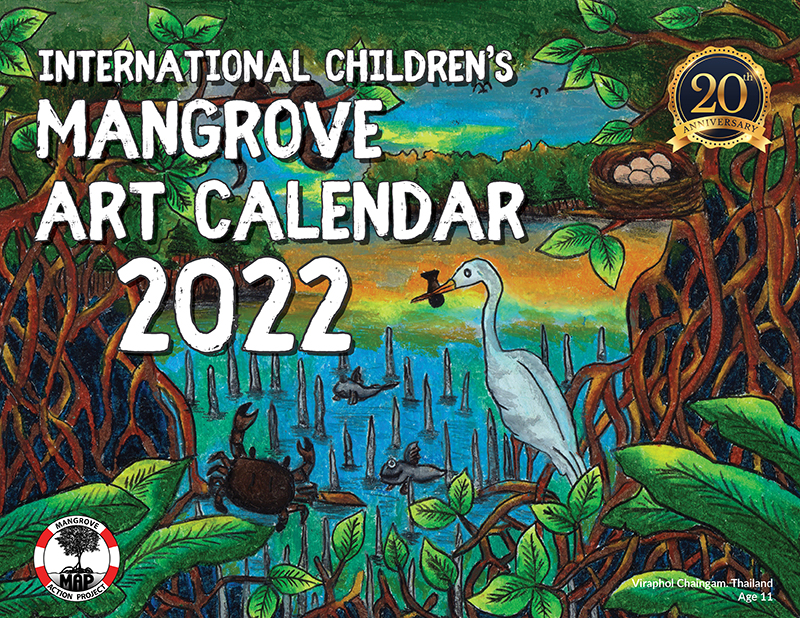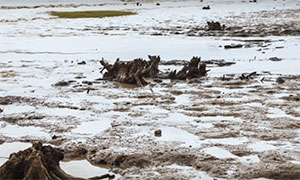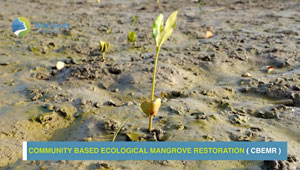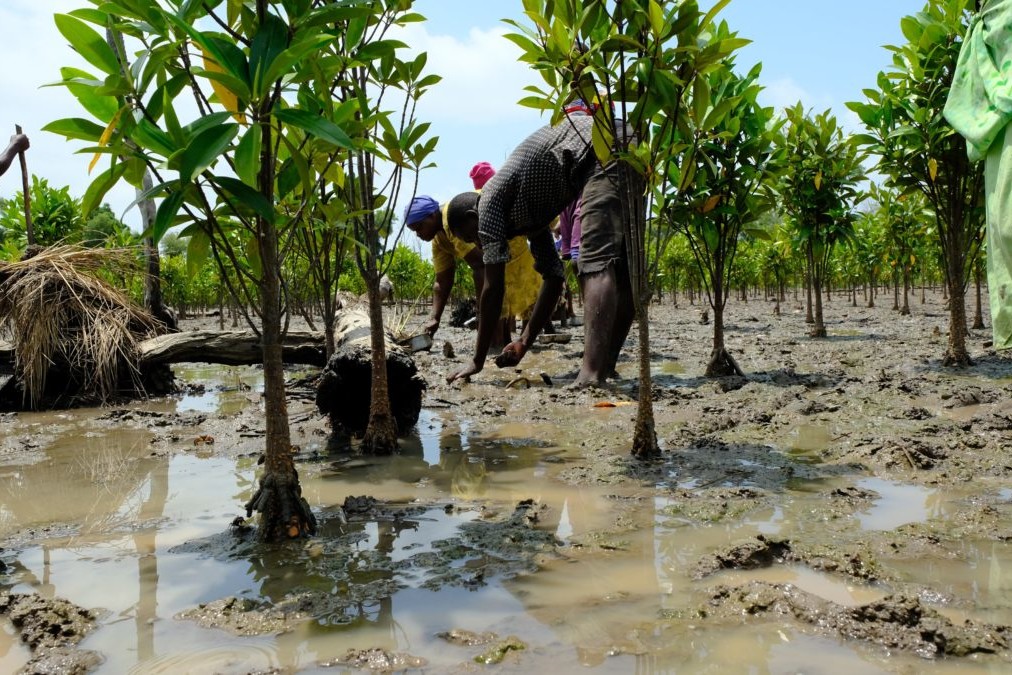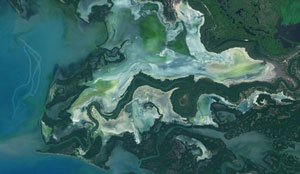|
The MAP News |
|
|
MAP Website en Español haga clic aqui
FEATURED STORY Co-existing mangrove-coral habitats have a new global classification system 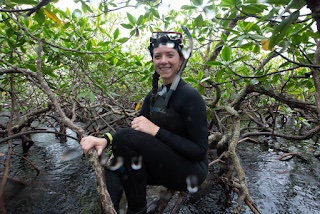 GLOBAL - On any given day between 2016 and 2019, Heather Stewart could be found snorkeling in between mangroves in the Bocas del Toro archipelago along Panama’s Caribbean coast. For years she visited these forests at the interface between land and sea, trying to understand what drove corals to grow inside them. Corals and mangroves often grow near each other in tropical coastal environments, but finding them sharing the same habitat appeared to be an evolutionary trait that deserved an explanation. With this in mind, a group of researchers that included Stewart and other scientists from STRI, the University of Miami, Santa Fe College and the University of Florida set out to create a system to classify coexisting mangrove-coral (CMC) habitats around the world. They reviewed scientific studies and identified the main characteristics and conditions occurring in these ecosystems. “We believe it is important to have a global classification system for coexisting mangrove-coral habitats because for nearly a century these systems have been known to exist, but were largely ignored by the scientific community,” said Stewart. “Now with all the threats corals face from ocean warming and acidification to pollution and sedimentation, corals are becoming more susceptible to diseases. Thus, there is greater interest in potential refugia to aid in the future of coral survival.” READ MORE GLOBAL NOW OPEN FOR SUBMISSIONS! Mangrove Photography Awards 2022  USA - The Mangrove Action Project is getting ready to launch the 8th Mangrove Photography Awards to promote mangrove forests in celebration of World Mangrove Day. The contest offers a chance for photographers of all levels to raise their voices for the protection of one of our most critical ecosystems, whilst giving us a fascinating insight into the world of mangroves from all corners of the earth. Through the power of imagery,your photos can reveal the importance and diversity of life in our coastal forests and help inspire action to conserve our mangrove ecosystems. The Mangrove Photography Awards is open to everyone of all ages; all photography enthusiasts and professionals worldwide for a chance to win cash prizes and products donated by our partners Follow us on Instagram and Facebook to keep up to date with the contest and mangrove stories. Please get in touch if you are interested in helping to promote the contest, World Mangrove Day and the importance of our mangroves, through powerful imagery. Contact leo@mangroveactionproject.org Remote sensing helps track carbon storage in mangroves  GLOBAL - In a recent study in Scientific Reports, researchers from the Institute of Industrial Science, The University of Tokyo, developed a model to assess the productivity of coastal mangroves in China. Mangroves grow along tropical coastlines and are regularly inundated by seawater. These unique species are well adapted to tropical coastal habitats and have special features such as aerial roots and salt-tolerant tissues that enable them to thrive under dynamic conditions. As a result, the productivity of mangrove forests is influenced by a range of environmental factors, such as sea surface temperature, salinity, and photosynthetic active radiation. In the past, light use efficiency models have been used to assess the productivity of terrestrial forests but there are no such models for more complex mangrove ecosystems. "Previous attempts to model mangrove productivity have used field measurements and produced estimates at a local scale," says lead author of the study, Yuhan Zheng. "But to truly understand the capacity for mangroves to store carbon, global assessments are needed, and these require measurements of environmental conditions on a much larger scale." READ MORE AMERICAS World’s biggest bacterium found in Caribbean mangrove swamp
 FRENCH ANTILLES - Scientists have discovered the world’s largest bacterium in a Caribbean mangrove swamp. Most bacteria are microscopic, but this one is so big it can be seen with the naked eye. The thin white filament, approximately the size of a human eyelash, is “by far the largest bacterium known to date,” said Jean-Marie Volland, a marine biologist at the Lawrence Berkeley National Laboratory and co-author of a paper announcing the discovery in the journal Science. “It’s an amazing discovery,” said Petra Levin, a microbiologist at Washington University in St Louis, who was not involved in the study. “It opens up the question of how many of these giant bacteria are out there — and reminds us we should never, ever underestimate bacteria.” READ MORE Dig, dump, repeat, then watch the forest grow 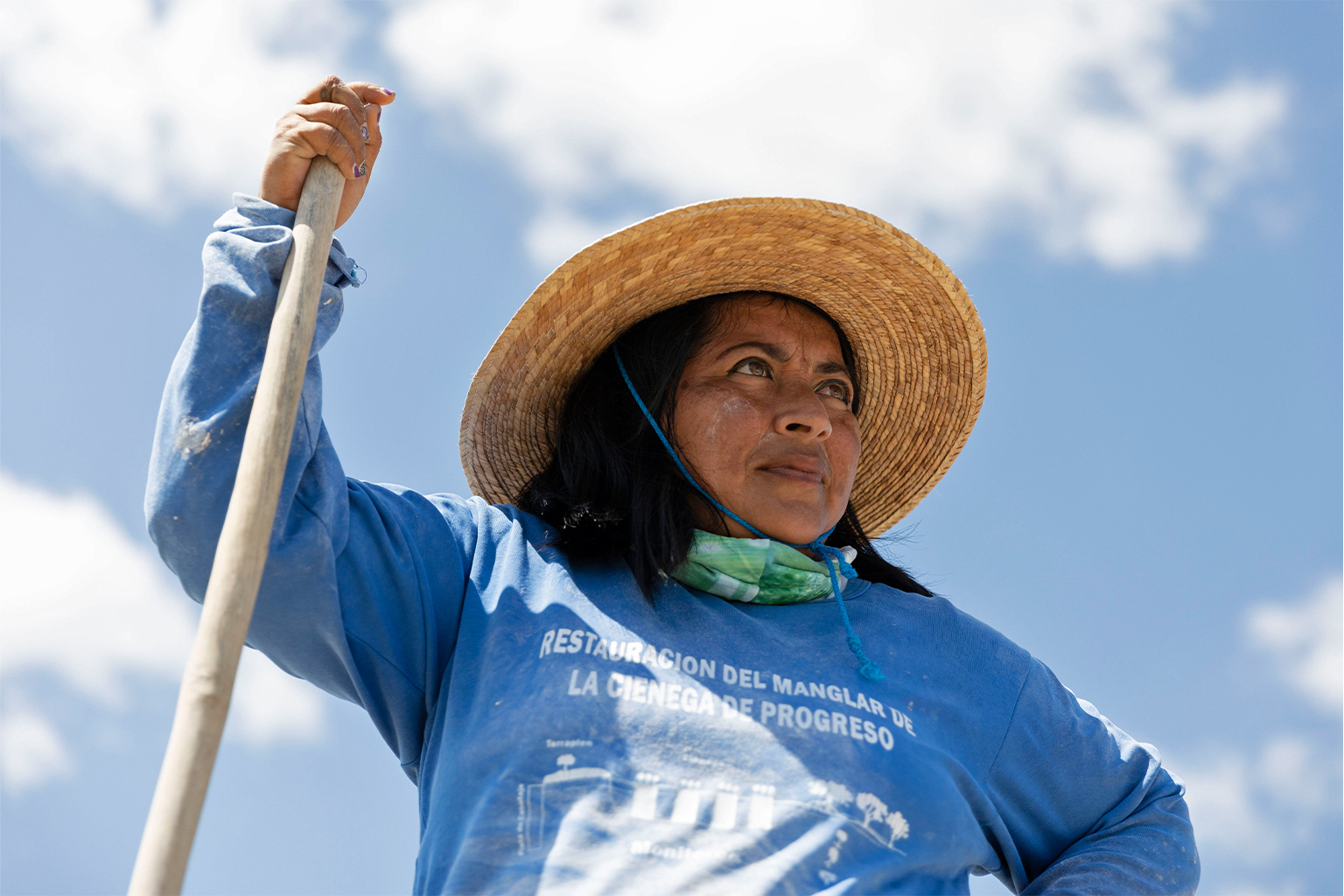 Mexico — In Mexico’s Yucatán Peninsula, a few words describe the most common occupations: fisher, merchant, mother. Over the past decade, the port town of Chelem has seen the emergence of a new line of work. Starting in 2010, a group of 18 local women, many of them descended from the Maya, have undertaken the conservation and restoration of their local mangrove forests. They call themselves Las Chelemeras Located 51 kilometers (32 miles) north of the city of Mérida, Chelem borders some 100 hectares (247 acres) of red and black mangrove trees, where crocodiles, crappies and kingfishers abound among a menagerie of native species. In recent decades, however, an outsized push for tourism and urban development has caused the deterioration, and in some cases deforestation, of the surrounding mangrove ecosystem. READ MORE Mangroves need Everglades restoration now more than ever 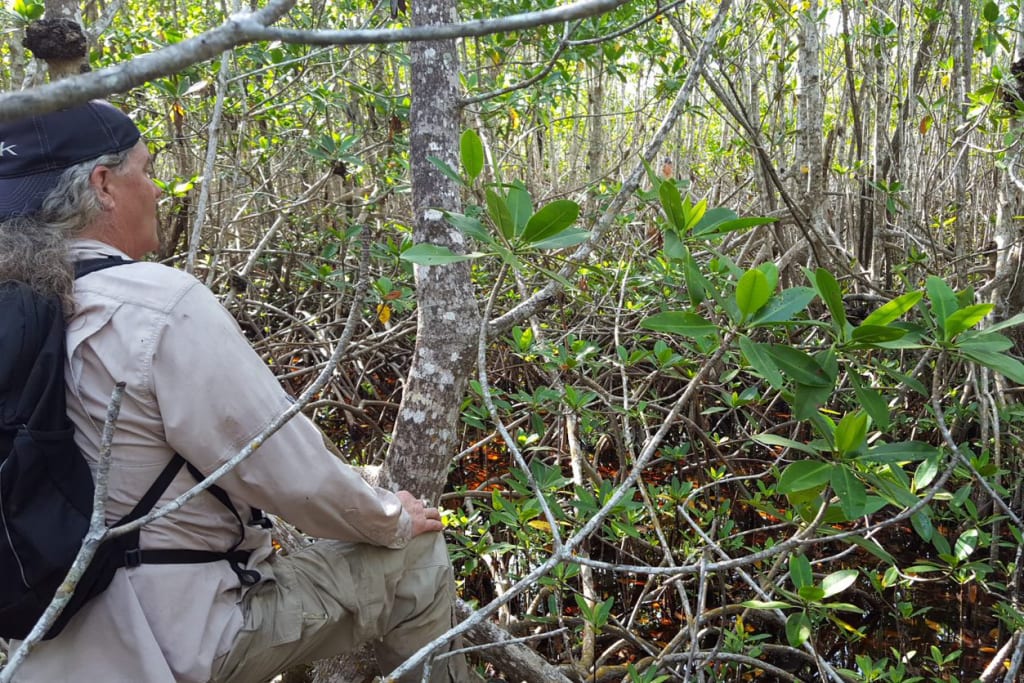 USA - Sea level rise is outpacing South Florida’s coastal wetlands, according to a new Florida International University (FIU) study. That means the iconic twisted and long-legged roots of South Florida’s mangroves could be drowned by rapidly rising seas by the end of the century. National Oceanic and Atmospheric Administration (NOAA) data shows in the last 20 years, the average rate of sea level rise in South Florida has accelerated faster than previously thought, increasing from 6.5 mm to 9.4 mm a year, compared with the historical rate of 3.9 mm a year. Without mitigation efforts, open water could replace the areas where mangrove forests currently reside. The new projections are a clear sign mangroves are in need of urgent help. But there is also a clear, actionable solution according to the researchers. “Mitigate, mitigate, mitigate,” said Randall Parkinson, a coastal geologist in the FIU Institute of Environment and lead author of the study. “A healthy patient responds better to a virus or other health threat than a sick patient. Our coastal wetlands are sick, and we need to help them get better — like rehydration, removal of topographic barriers — to optimize their chances of survival.” READ MORE Mangrove and reef restoration yield positive returns on investment for flood protection 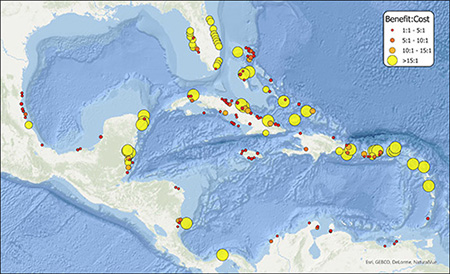 USA - A new analysis demonstrates that restoration of mangroves and coral reefs can be a cost-effective solution for coastal flood reduction in more than 20 countries across the Caribbean. The study, published May 28 in the journal Ecosystem Services, used methods from the risk and insurance industry to provide rigorous valuations of these natural defenses and show that they can deliver a positive return on investment, with the benefits from reduced flood damage exceeding the costs of restoration. The results point toward new opportunities to support restoration efforts with funds from sources that support hazard mitigation, climate adaptation, and disaster recovery, including the U.S. Federal Emergency Management Agency (FEMA). “We identify a number of funding sources that have traditionally supported artificial ‘gray infrastructure,’ such as concrete sea walls, and that could be applied to nature-based solutions,” said lead author Michael Beck, a research professor in the Institute of Marine Sciences at UC Santa Cruz who holds the AXA Chair in Coastal Resilience. READ MORE Mangrove nursery takes root 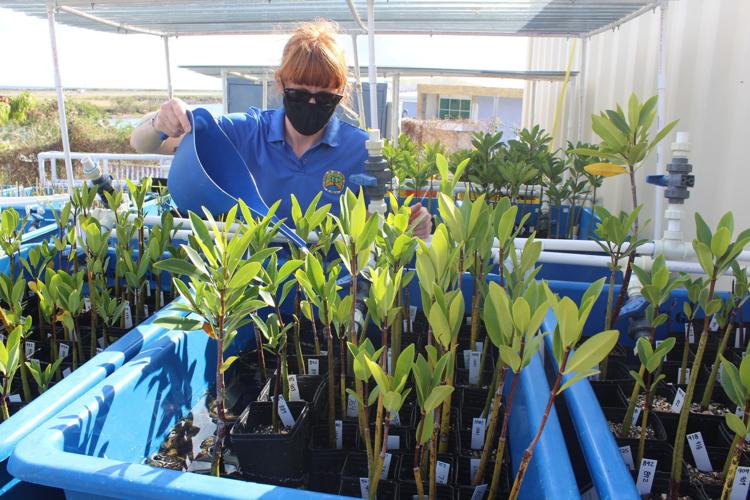 ST. THOMAS - In the back of the Marine Biology Center at the University of the Virgin Islands’ Kean Campus, sits rows of large blue tubs filled with green mangrove sprouts. The sprouts are tended to by the GRROE USVI Mangroves research team, and will one day be planted at sites throughout the territory designated for recovery efforts. GRROE stands for the team’s mission, which is to grow research, restoration, outreach and education of the territory’s mangrove ecosystems Allison Holevoet, a second-year grad student at UVI, conducts research in the nursery, and carefully studies the sprouts to ensure their survival. In order to combat mangrove habitat loss the land-based mangrove nursery was constructed in 2021 by a cohort of graduate and undergraduate students led by professor Kistin Wilson Grimes. The project is funded under a five-year, $20 million Ridge to Reef grant awarded to V.I. EPSCOR. Researchers were permitted to go out into the field and collect any mangrove seedlings, known as propagules, that had fallen to the ground. READ MORE WWF Looking to Raise Mangrove Restoration Targets  BELIZE - The World Wildlife Fund (WWF) is looking to embark on an initiative to battle the effects of climate change through mangrove restoration. Belize is home to three species of mangroves, namely the red, black and white. According to the Senior Director of WWF, Nadia Bood, mangroves act as carbon sinks that reduce the acidity in the waters and absorb excess carbon from the atmosphere. She says the WWF and the Government of Belize are looking to raise the targets of restoration and protection of mangroves. “There are science based targets for restoration of mangroves and protection of mangroves and so with our work we are hoping to do the research and build the capacity so that we can then start to replicate restoration of mangroves across Belize’s coastline to help Belize as a country meet those targets,” said Bood. VIEW SOURCE ASIA After decades of loss, the world's largest mangrove forests are set for a comeback 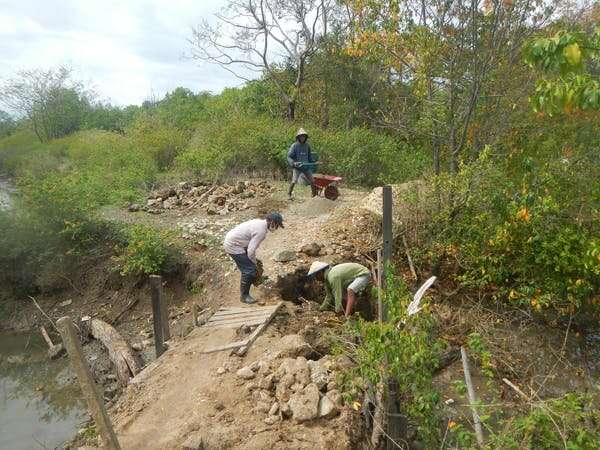 INDONESIA - Mangroves ring the shores of many of Indonesia's more than 17,000 islands. But in the most populated areas, the world's largest mangrove forests have been steadily whittled away, and with them, the ability to store blue carbon. You might think it's too hard to restore mangroves once they've been turned into shrimp farms. Previously, this has been true, with an over-reliance on simply planting more seedlings rather than tackling the harder work of social and economic reliance on former mangrove habitat. In response, Indonesia's government has mapped around 77,000 hectares of the best restoration candidate areas across 300 villages in Sumatra and Kalimantan (Indonesian Borneo), working in full collaboration with coastal villagers. To create alternatives to aquaculture, Indonesia's national farmer field school program will expand to include hundreds of coastal villages. READ MORE Ratsada to create mangrove eco-tourism nature trails  THAILAND - Ratsada Mayor Nakarin Yosangrat has gained support to use one tract of 101 rai of natural forest and mangroves and another area covering 10 rai to use together as a protected nature reserve complete with nature trails as an eco-tourism attraction. The support for the ‘Ratsada Green in the City’ project (also called the ‘Ratsada Urban Forest Project’) came at a meeting at the Ratsada Municipality offices yesterday (June 22). At the meeting the project gained the approval of the Phuket Mangrove Forest Resource Management Center, Phuket Rajabhat University and the Department of Marine and Coastal Resources.READ MORE Pangasinan school’s mangrove project makes it among ‘World’s Best’ 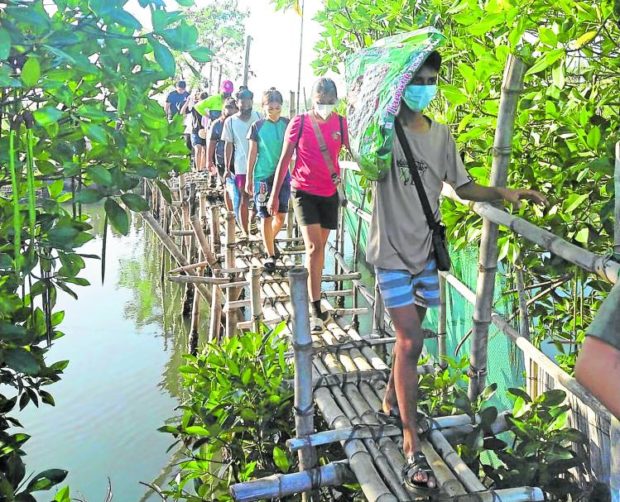 PHILIPPINES - From just a small project 10 years ago, Bonuan Boquig National High School’s environmental initiative of planting mangroves in Dagupan City, Pangasinan province, has brought the school to the shortlist of the World’s Best School Prizes, awarded by international educational group T4 Education. School principal Renato Santillan recalled that Typhoon “Pepeng” (international name: Parma) in 2009 had left heavy damage on fishponds, rivers, and mangroves in their barangay, after which the high school is named. This prompted them to start a project of growing new trees to help support students and their families, who subsisted on their catch at the mangroves before disaster struck. “Recently, one of our students said the initiative became a huge help because they were able to get oysters that grow at the roots of mangroves. [The oysters were] their food amid the [COVID-19] pandemic,” Santillan said in a recent phone interview. READ MORE LAST WORD Dear Friends, I hope all is going well with you and your work. I am sending a short survey about the current situation regarding shrimp farming and its effect on mangroves today. I am hoping to gain a more current view of the situation because it seems that much less focus is on problem areas where shrimp farm expansion still plays a significant role in contributing to mangrove loss. Please see the survey questionnaire we at MAP put together. Your help in responding to these questions would be much appreciated, and please pass this on to others whom you feel might add to our survey. I may attend a major aquaculture conference in Seattle in October and want to have a report I can bring that would highlight where the shrimp industry is still having major adverse effects on mangroves and local communities. This could put due pressure on the industry to clean up its act in those areas particularly. I hope to hear from you soon! For the Mangroves, Alfredo Quarto, MAP TAKE THE SURVEY Like this newsletter? *Articles in this newsletter may mention practices being used and/or show exagerated results being claimed without proof. Stories are presented here in effort to show mangrove related activity around the world and do not necessarily reflect Mangrove Action Project's views or mangrove restoration best-practices. |
ACTION ALERTS
MAP Website en Español
13 Year old Linda Li "Mangrove Adventure" from Kid Dream Art School
Video: Mangroves for the Future WANT TO GET INVOLVED?
Like this newsletter? Pease consider donating to MAP to keep it going. Giving could never be easier
Interested in connecting or working with MAP? Check out our opportunities here MANGROVE ISSUES Want to learn more about mangroves? What is CBEMR? Download MAP's 2 page CBEMR Information Sheet containing links to all MAP's CBEMR resources – CLICK HERE View MAP’s uploaded Videos at Question Your Shrimp Consumer/Markets Campaign! Mangroves: Guidebook to Malaysia – Click Here SHARE MAP'S VISION Our short documentary, Reducing the Risk of Disaster through Nature-Based Solutions : Mangroves
Marvellous Mangroves Curriculum The Marvellous Mangroves Curriculum begins with a simple philosophy – getting future generations to not only learn about, but understand the importance of mangrove forests. VISIT
Marvellous Mangroves Curriculum in Bangladesh - WATCH VIDEO
Like this newsletter? Pease consider donating to MAP to keep it going. Giving could never be easier
"Question Your Shrimp" Campaign Question Your Shrimp - is it really sustainable? Sign the Petition
We strive to keep active links in our newsletter. However, due to circumstances beyond our control, occasionally links to stories may become broken. If you find a link to a story is not functioning, please cut and paste the headline into your browser search bar. In most cases you should be able to locate the original story. Not yet a MAP News subscriber?
|
|
Mangrove Action Project Click here to view past newsletters
|
|
Search News Archive
Saturday, June 25, 2022
MAP News Issue #549 - June 25, 2022
Saturday, June 11, 2022
MAP News Issue #548 - June 11, 2022
|
The MAP News |
|
|
MAP Website en Español haga clic aqui
FEATURED STORY SAVE THE DATE - 24th June open for submissions Mangrove Photography Awards 2022  USA - The Mangrove Action Project is getting ready to launch the 8th Mangrove Photography Awards to promote mangrove forests in celebration of World Mangrove Day. The contest offers a chance for photographers of all levels to raise their voices for the protection of one of our most critical ecosystems, whilst giving us a fascinating insight into the world of mangroves from all corners of the earth. Through the power of imagery,your photos can reveal the importance and diversity of life in our coastal forests and help inspire action to conserve our mangrove ecosystems. The Mangrove Photography Awards is open to everyone of all ages; all photography enthusiasts and professionals worldwide for a chance to win cash prizes and products donated by our partners Follow us on Instagram and Facebook to keep up to date with the contest and mangrove stories. Please get in touch if you are interested in helping to promote the contest, World Mangrove Day and the importance of our mangroves, through powerful imagery. Contact leo@mangroveactionproject.org GLOBAL Mangroves matter for people and planet  GLOBAL - Mangrove forests sustain an incredible abundance of life, store vast amounts of carbon and provide food and income for millions of people around the world. But they are disappearing before our eyes. This World Biodiversity Day we must recognise the globally important role these ecosystems, and others like them, play in securing a thriving future for all life and act to protect them before it is too late. Mangrove forests make up one of the most productive and biologically diverse ecosystems on the planet, yet we are destroying them at an alarming rate. Hendrik Hermawan of Akar Bhumi, Indonesia, said: “We all were born with nature [and] have a strong connection with the plants; planting is part of our culture and livelihood…when we lost the mangroves, we also lost our determination, our spirit and our dignity.” Despite their clear and unique value, mangroves remain one of the most threatened habitats in the world and their destruction is rife across the globe. READ MORE AFRICA Growing the market for mangroves could be what saves them :quality(70)/cloudfront-eu-central-1.images.arcpublishing.com/thenational/6IXWMMBQ7VEF3K7UH2HM6NLPXQ.JPG) IVORY COAST- During a recent Friday afternoon, I met with the local tribal chiefs and community members in Adiake, a breezy fishing village on the banks of the Gulf of Guinea in eastern Ivory Coast. Sitting on firm wooden chairs by the coastline and looking onwards to the calm sea, we discussed my plans to plant 160,000 mangroves in a deforested area not far from where we were sitting. While the community members seemed receptive to the idea, it was clear that they were not entirely convinced. “What happens after the seedlings are planted?” said one of the tribal heads with a stern voice. “Who will care for them for 10 years to make sure they grow to become healthy mature trees?” This is a valid point. Most tree-planting projects look to cover only the cost of the planting and maybe a few years of monitoring. “What happens if we help you plant them and in five years a public official decides to parcel off the area and sell it to developers?” pronounced another weary tribal official. It’s a phenomenon that is not uncommon. READ MORE AMERICAS Mangrove restoration remains key to keeping South Florida shorelines safe and beautiful 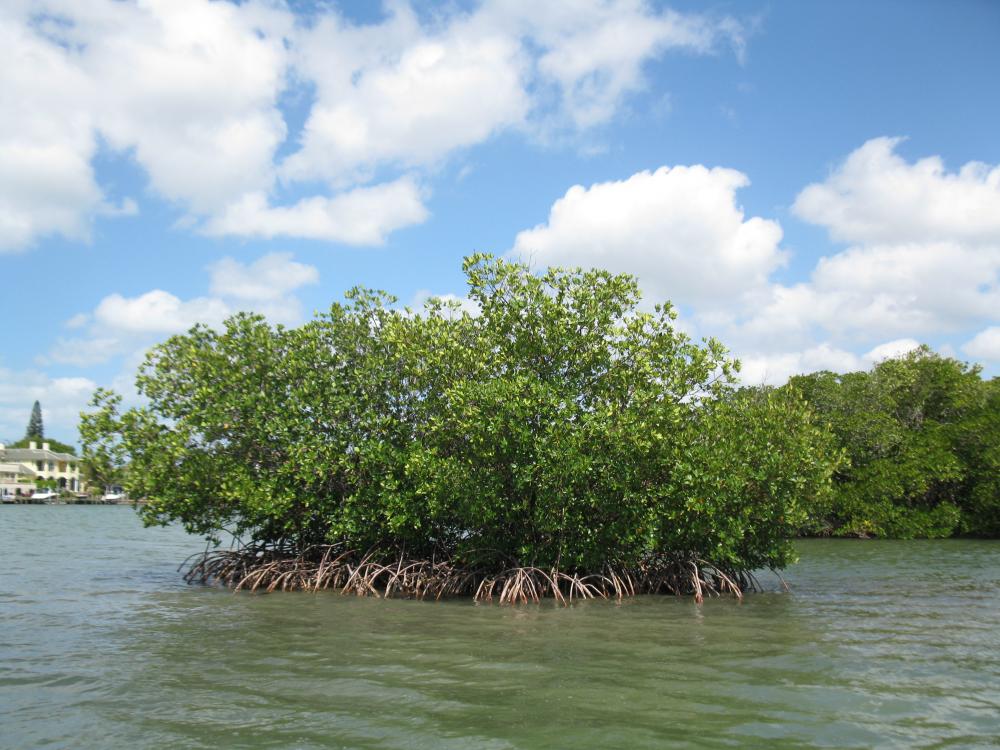 USA - Part of the Don’t Trash Our Treasure franchise has included discussing the benefits of restoring mangroves to South Florida’s shorelines, especially when it comes to protecting us from storm surge and sea level rise The City of Miami was actually considering banning the planting of new mangroves That sparked a heated debate between those in favor of creating living shorelines and those against obstructing million dollar views of Biscayne Bay An impassioned chorus of concerned residents and scientists pleaded with City of Miami commissioners at a recent city commission meeting to kill a controversial ordinance sponsored by Commissioner Joe Carollo to ban the planting of mangroves in City of Miami parks “Parks are actually one of the last places that we have to actually plant mangroves,” Dr. Rachel Silverstein, Executive Director of Miami Waterkeeper, said during the meeting The ordinance was officially withdrawn after Commissioner Ken Russel asked Carollo to pull it. READ MORE Editor's note: Although this story is not about mangroves, the fact that a 5,000 year-old living being exists on our planet is at the heart of world forest conservation. MAP applauds the efforts to protect this tree, known as “Great Grandfather” Ancient Tree in Chile Could Be World's Oldest, Scientists Say 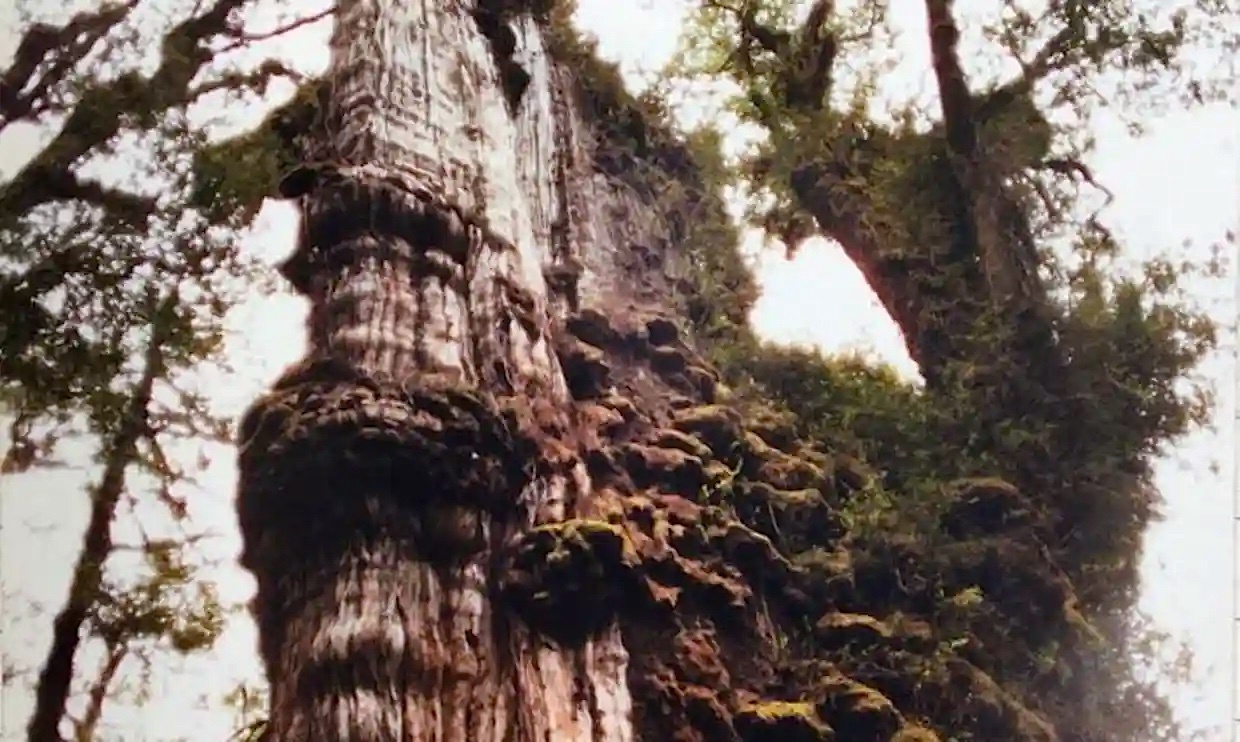 CHILE - An ancient cypress in southern Chile could be more than 5,000 years old, making it the world’s most aged tree, new research finds. Known as “Great Grandfather,” the endangered alerce tree lies in a ravine in Alerce Costero National Park. Scientists estimated its age using computer models based on data gathered from a sample. The findings suggest that the tree is older than the current record-holder, Methuselah, a 4,853-year-old bristlecone pine in the White Mountains of California. Barichivich, who led the research on Great Grandfather, said the tree could be as much as 5,484 years old. Great Grandfather is in a precarious position, with visitors to Alerce Costero National Park often stepping on its roots and or taking pieces of its bark, Barichivich said. Drier conditions are also stressing the tree. Noting the impacts of climate change, Barichivich told Reuters that he hoped people could “think for a fraction of a second about what it means to live 5,000 years.” READ MORE ASIA Maldives plan to reclaim land for tourism could choke ecosystem 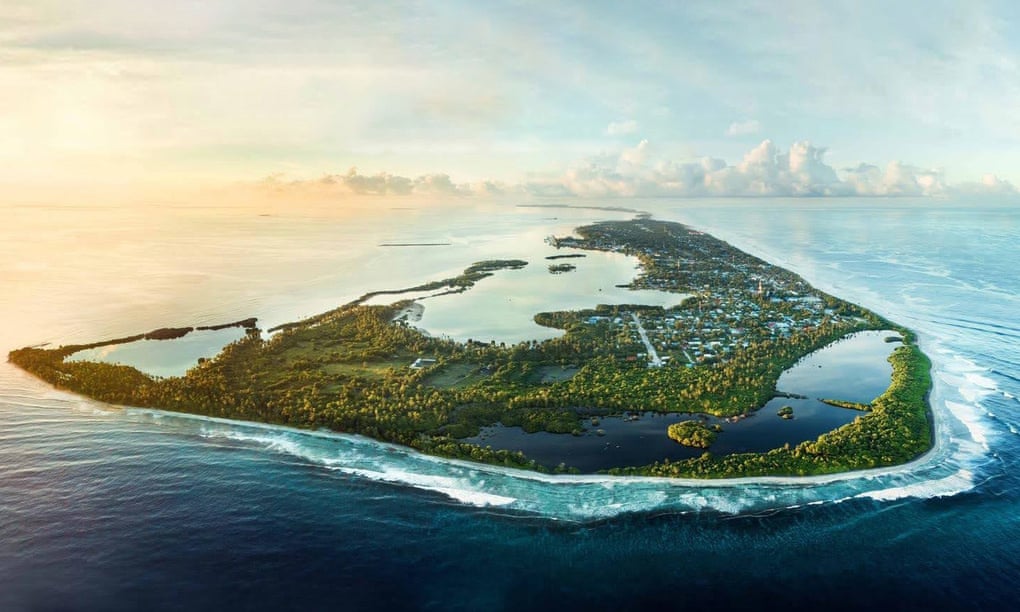 MALDIVES – A controversial project to reclaim land on an atoll threatened by rising sea levels has been announced in the Maldives, with hopes that it may boost tourism balanced against fears that it could “choke the ecosystem” The low-lying island nation, one of the world’s most vulnerable to climate change, has commissioned a major shore protection and land reclamation scheme using sand dredged from a lagoon, despite concerns about the impact on this Unesco biosphere reserve A Dutch marine contractor, Van Oord, has announced it will create 194 hectares (480 acres) of land, including three new island resorts, in the southern atoll of Addu City – part of a Maldives government project to stimulate the local economy, tackle land shortage and protect the coastline. The scheme will reportedly cost $147.1m (£117m) and be funded via an Indian bank According to Van Oord, up to 5m cubic metres of sand will be dredged from a lagoon in the middle of the six islands, which are home to at least 20,000 people. Other estimates put the amount of sand to be removed at 6.9m cubic metres. READ MORE Land reclamation development project in the Maldives is adding to climate crisis.  MALDIVES - On 27 March, the Maldives’ president Ibrahim Mohamed Solih ceremonially signed off on a land-reclamation project spanning 194.3 hectares of land in Addu City, part of the Maldives’ southernmost atoll, one of many signed during his tour of the atolls in the south. According to news reports, preparations for beginning the reclamation process are already underway. In contradiction to government-led demands for climate action overseas, environmental activists say the project will “effectively destroy” the biodiversity of the region, which holds UNESCO Biosphere Reserve status since 2020 for its one-of-a-kind reef structures, home to diverse marine life The Dutch company which was awarded the tender for dredging the land by the government, Van Oord (India), will carry out development through a direct line-of-credit facility from India Exim Bank. Their contract alone is worth over USD 84 million. The project aims to conduct extensive land reclamation in Addu in order to develop residential housing, commercial buildings and luxury resorts. Meanwhile, the work to build a new causeway linking Hithadhoo and Maradhoo islands was contracted to an Indian company named Afcons Infrastructure Limited to the tune of USD 147.1 million. READ MORE Mangrove Afforestation in the Mekong Delta for sustainable coastal resilience  The mangrove belt and the coastal zone of the Mekong-Delta are in a serious state of degradation. This is of serious concern, since in this soft-sediment environment, the mangrove-sea-dike combination (green-grey) is the preferred option for a sustainable coastal defence system at acceptable construction and maintenance costs. The Mekong Delta cannot rely on the relatively rigid dike structure alone, subject to foreshore and dike erosion, subject to direct wave attack Degradation is the result of a long-term development, not only of the mangroves trees themselves. It concerns lack of sediment even far upstream the Mekong River (sand mining, dams), the land use in the coastal zone pressing the dike seaward, leaving too little intertidal zone for the mangroves, the inadequate water management and overexploitation of groundwater resulting in land subsidence, four to five times more serious than sea-level rise. A mangrove belt, partly or fully developed mitigates many of these problems, but flanking measures remain important to address the beforementioned issues. Specific for the Mekong Delta is also the pressure from inland shrimp farming. Modernisation of its water management and a cascade system may well contribute to co‑existence with a well-developed mangrove coast. READ MORE Bangladeshi coastal communities plant mangroves as a shield against cyclones  BANGLADESH - Over the past three decades, Moyna Rani Mondol, who lives right on the coast in Bangladesh’s southwestern district of Satkhira, has lost her home around 10 times to floods due to tidal surges Bangladesh is a large delta crisscrossed by more than 300 rivers. It’s one of the most vulnerable countries to natural disasters like floods, tropical storms and cyclones, inducing coastal erosion and soil salinization Most coastal villages here have the protection of several dikes and embankments built along the coasts to separate themselves from the sea as well as the tidal surges during high tides and cyclones The coastal people are no strangers to the tidal surges during high tides. But during the cyclone season, when the surges are much higher and more severe than usual, they flood the settlements by breaching the dikes and embankments set up to protect the communities. Now, each time a cyclone makes landfall, the villages get flooded. READ MORE OCEANA Australian Indigenous Weather Knowledge on Display in New Documentary Series 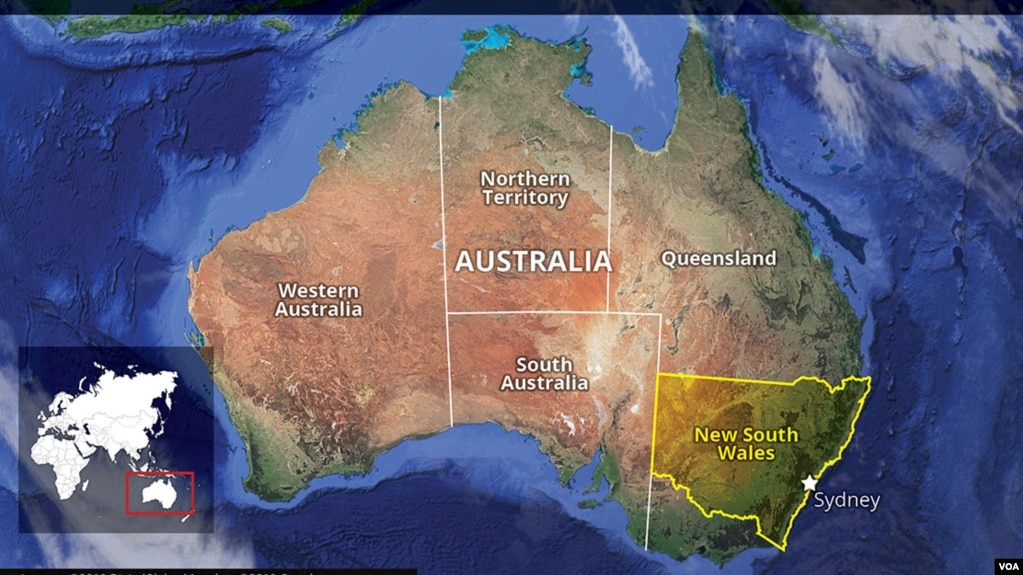 On the Tiwi Islands, north of the Australian city of Darwin, Indigenous groups mark, among many others, the season of the mangrove worm, when the creeping invertebrates become a sweet, filling and easy meal. First Nations seasonal calendars show an intricate knowledge of the relationships between plants, animals, water, the weather, and fire. The ‘Many Lands, Many Seasons’ documentaries are a collaboration between the Australian Broadcasting Corp. and the national science agency, the Commonwealth Scientific and Industrial Research Organization, also known as the CSIRO. Over the past 15 years, scientists have helped Indigenous communities in Australia document and present the way they understand complex weather pattens. Their knowledge of the seasons is highly localized and unique to each area. Subtle changes in the weather tell communities when to pick fruit, hunt and fish. READ MORE Like this newsletter? *Articles in this newsletter may mention practices being used and/or show exagerated results being claimed without proof. Stories are presented here in effort to show mangrove related activity around the world and do not necessarily reflect Mangrove Action Project's views or mangrove restoration best-practices. |
ACTION ALERTS
MAP Website en Español
13 Year old Linda Li "Mangrove Adventure" from Kid Dream Art School
Video: Mangroves for the Future WANT TO GET INVOLVED?
Like this newsletter? Pease consider donating to MAP to keep it going. Giving could never be easier
Interested in connecting or working with MAP? Check out our opportunities here MANGROVE ISSUES Want to learn more about mangroves? What is CBEMR? Download MAP's 2 page CBEMR Information Sheet containing links to all MAP's CBEMR resources – CLICK HERE View MAP’s uploaded Videos at Question Your Shrimp Consumer/Markets Campaign! Mangroves: Guidebook to Malaysia – Click Here SHARE MAP'S VISION Our short documentary, Reducing the Risk of Disaster through Nature-Based Solutions : Mangroves
Marvellous Mangroves Curriculum The Marvellous Mangroves Curriculum begins with a simple philosophy – getting future generations to not only learn about, but understand the importance of mangrove forests. VISIT
Marvellous Mangroves Curriculum in Bangladesh - WATCH VIDEO
Like this newsletter? Pease consider donating to MAP to keep it going. Giving could never be easier
"Question Your Shrimp" Campaign Question Your Shrimp - is it really sustainable? Sign the Petition
We strive to keep active links in our newsletter. However, due to circumstances beyond our control, occasionally links to stories may become broken. If you find a link to a story is not functioning, please cut and paste the headline into your browser search bar. In most cases you should be able to locate the original story. Not yet a MAP News subscriber?
|
|
Mangrove Action Project Click here to view past newsletters
|
|
-
The community of adults and youth in Cayman Islands has come together recently to release a series of educational videos. Each is geared to...
-
By Alfredo Quarto, Program & Policy Director Co-founder, MAP There is a rather urgent situation concerning the bio-invasion of the Son...
-
By: Isabel Robinson, MAP Volunteer Intern Some months ago I decided to come to Thailand and do an internship in mangrove conservation, ...
MAP News Issue #596 = April 20, 2024
ENTRIES NOW OPEN! Mangrove Photography Awards 2024 10 Years Celebrating Mangroves GLOBAL - MAP has launched our 10th Mangrove Photograp...



